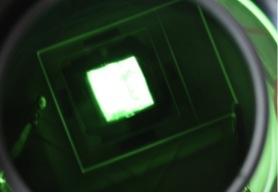Oct 16 2014
A new type of carbon nanotubes-based, flat, energy-efficient light source has been developed by researchers from the Tohoku University in Japan.
This light source challenges the dominance of LEDs as the most energy-efficient lighting solution. It demonstrates a very low 0.1Wh power consumption that is approximately hundred times lower than the consumption of standard LEDs.
 This is a plane-lighting homogeneity image of a planar light source device through a neutral density filter. Credit: N.Shimoi/Tohoku University
This is a plane-lighting homogeneity image of a planar light source device through a neutral density filter. Credit: N.Shimoi/Tohoku University
Presently, electronics based on carbon nanotubes (CNTs) are also being used for production of semiconductor materials. The new device has carbon nanotubes as electrodes and a phosphor screen in a diode structure. For making the device, the researchers dispersed carbon nanotubes in an organic solvent with a surfactant.
This mixture was painted onto the cathode and its surface was then scratched to form a stable light panel that could produce homogenous emission current while consuming low energy. The 'diode' panel achieved 60lm/W brightness efficiency, while LEDs can produce 100lm/W and OLEDs can produce 40lm/W of brightness efficiency.
The luminescence systems in the device act like cathode ray tubes. The phosphor screen acts like an anode, while the carbon nanotubes act as cathodes. The phosphor screen is in a vacuum cavity. These cathodes, through their nanotube tips, emit beams of electrons at high-speed. This occurs due to the phenomenon of field emission. The emitted electrons hit the phosphor screen and glow. High brightness homogeneity and zero flicker field emission current were also achieved.
Field emission electron sources can deliver easily controllable, intense and more directional stream of electrons when compared to conventional thermionic cathodes. Further, highly crystalline single-walled carbon nanotubes (HCSWCNT) have negligible defects in the surface carbon network.
When compared to other lighting devices, the new flat-panel device demonstrated lower loss of energy, which allows it to be used for energy-efficient cathodes. The flat-plane emission device could also help reduce emissions of carbon dioxide, benefitting the environment.
This study has been published in the Review of Scientific Instruments journal.